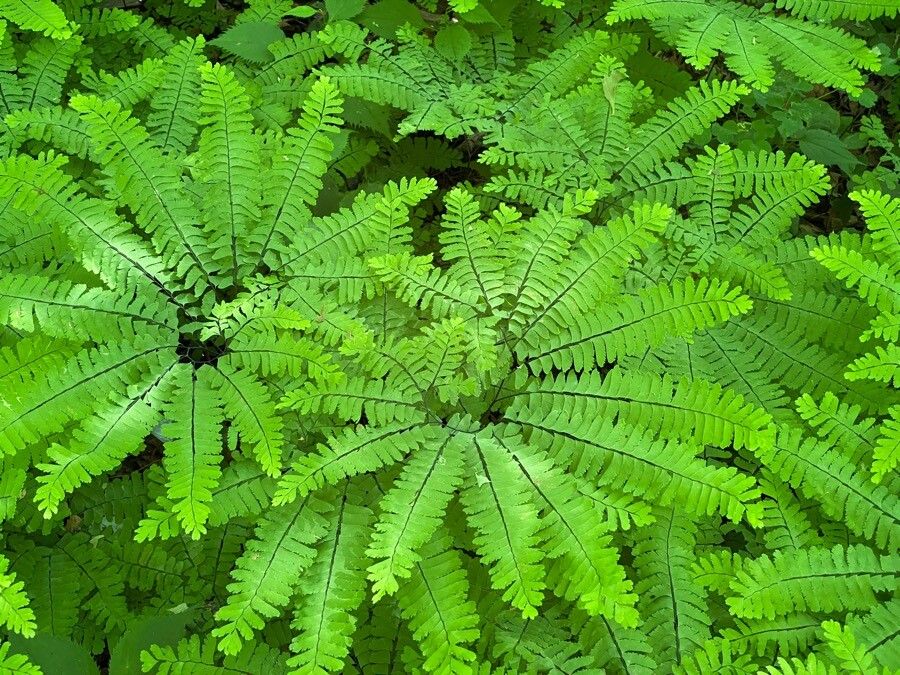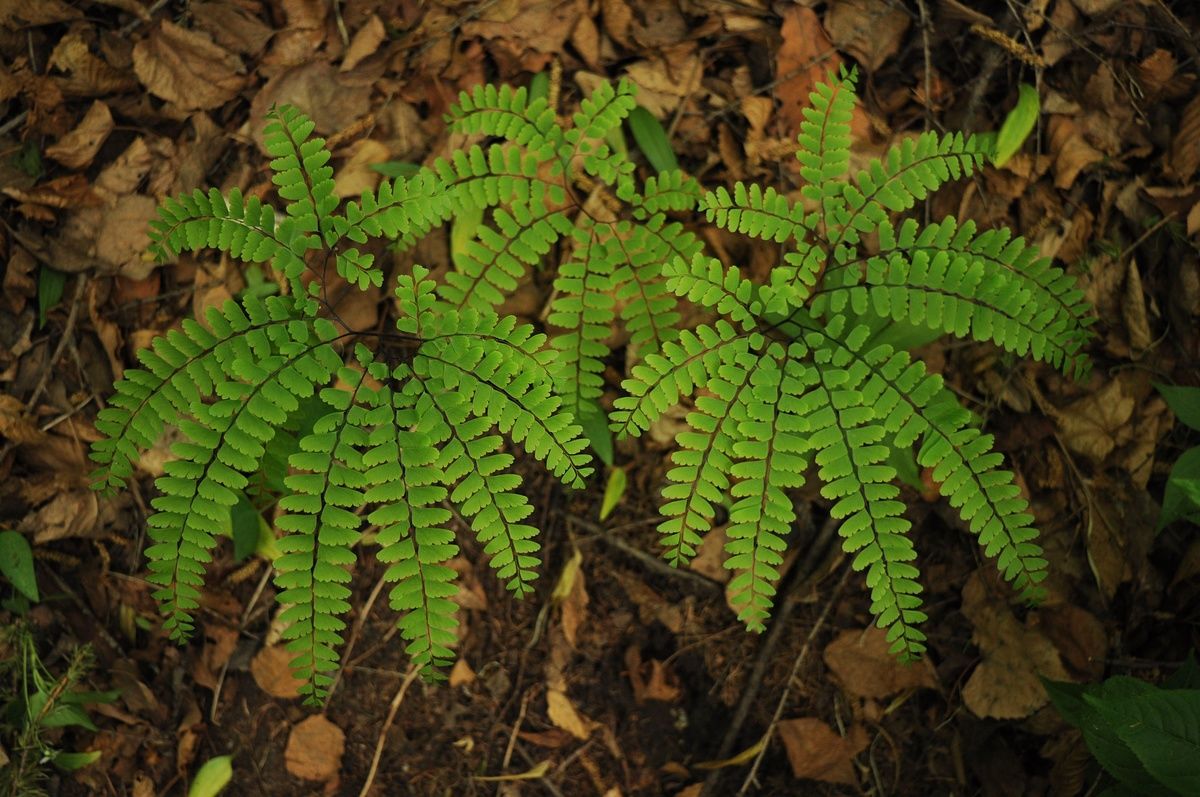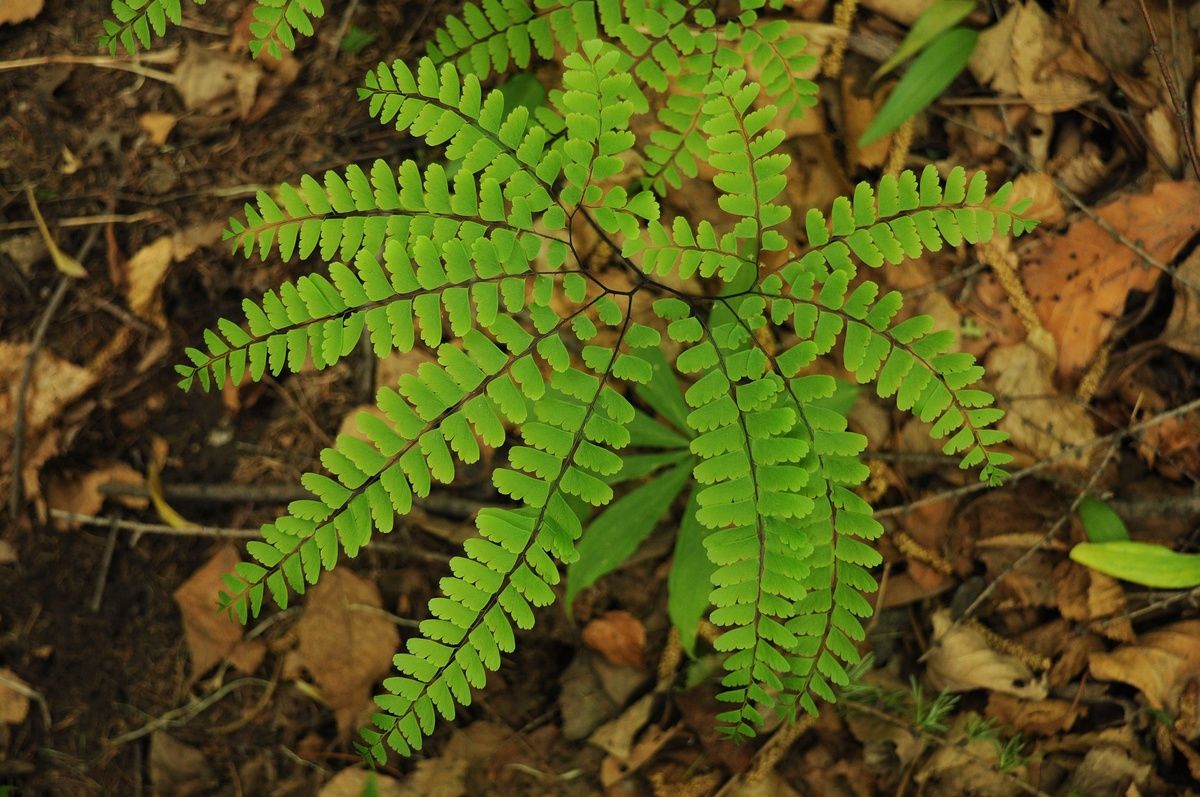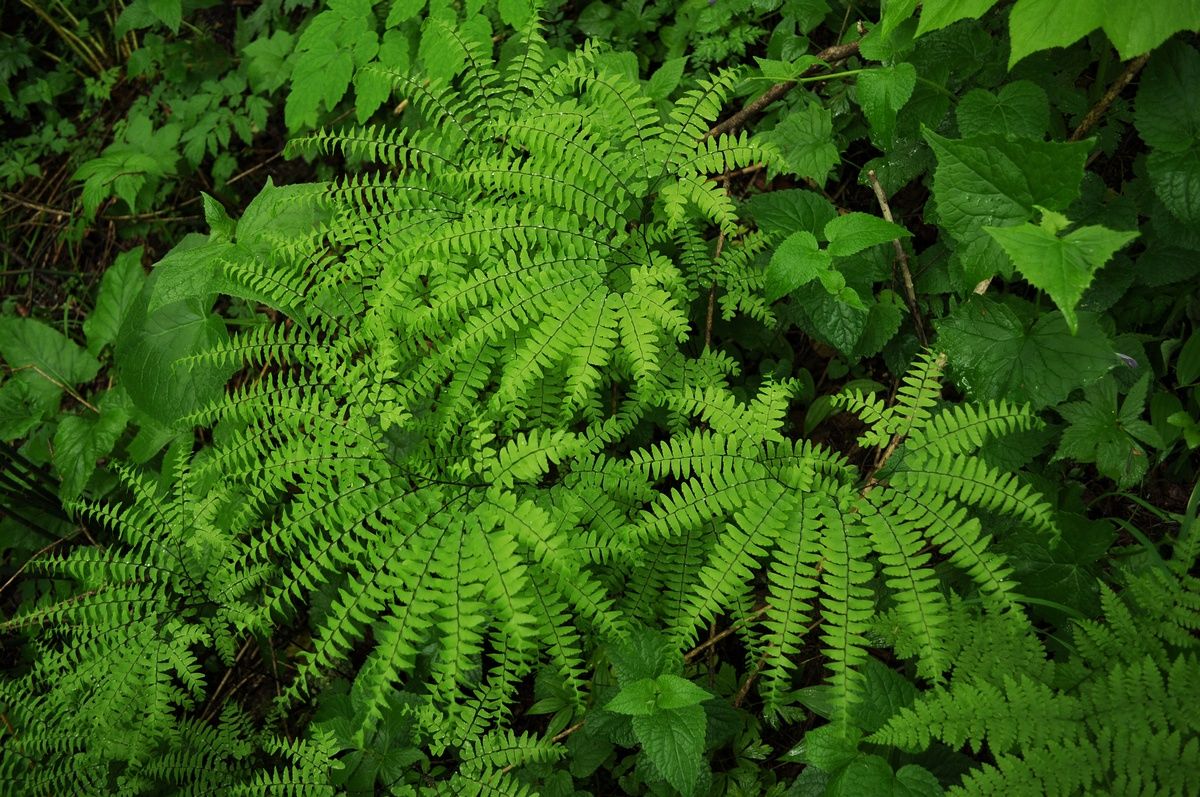Maidenhair Fern
adiantum pedatum
Also known as: ["Northern Maidenhair Fern","Five-Fingered Fern"]
Overview
A delicate, deciduous fern with distinctive fan-shaped fronds and black stems.
Benefits & Perks
["shade tolerant","aesthetic foliage","wildlife attractant (bees, butterflies, birds)"]
Botanical Classification
| Phylum: | Tracheophyta |
| Class: | Polypodiopsida |
| Order: | Pteridales |
| Family: | Pteridaceae |
| Genus: | Adiantum |
| Botanical Name: | Adiantum pedatum |
Plant Characteristics
Basic Information
- Category: Leaf Plants
- Suitable Location: shaded garden bed or indoor pot with indirect light
- Suitable For:
- Is Weed: No
- Allergenicity: low
Environmental Needs
- Climate: {"temperatureRange":"0–30°C"}
- Hardiness: {"zones":"3–8"}
- Misting: every 2–3 days, especially in dry indoor environments
- Drainage: Well-draining to fast-draining to prevent waterlogging.
- Soil Type: Rich, well-draining, slightly acidic soil with organic matter like peat moss or compost.
Maintenance Level
- Maintenance Level: moderate
- Toughness Level: moderate
- Pruning Frequency: As needed throughout the year; more frequently during active growth if fronds become crowded.
- Pruning Intensity: Light to moderate; focus on selective removal rather than heavy cutting.
Care Details
Ideal Sunlight Coverage:
Bright indirect light for 4–6 hours daily; avoid direct sunlight which can scorch fronds; adjust light exposure gradually if moving plant.
Sunlight Tolerance Tips:
Acclimate to new light conditions slowly over 1–2 weeks; protect from harsh afternoon sun; place in east-facing windows for ideal light.
Care Requirements
Care Difficulty
moderatemoderate
Sunlight
partial shade to full shade
Rotate plant weekly for even growth; use sheer curtains to filter direct light; monitor for signs of sunburn or etiolation.
Watering
every 7–10 days, allowing soil to slightly dry between waterings
Keep soil consistently moist but not waterlogged; avoid letting roots sit in water; water more during active growth.
Soil
moist, humus-rich, well-draining soil
pH: Slightly acidic to neutral (pH 5.5–6.5).
Use a peat-based mix; ensure pots have drainage holes; avoid heavy clay soils.
Temperature
Prefers cool to moderate temperatures (60–75°F or 15–24°C); tolerates mild fluctuations but avoid extreme heat or cold.
Avoid placing near heating/cooling vents; maintain stable temperatures; protect from sudden temperature drops.
Fertilizing
every 4–6 weeks during active growing season (spring and summer)
Apply fertilizer after watering to prevent root burn; flush soil occasionally to prevent salt buildup; stop fertilizing if plant shows signs of distress.
Propagation
Methods
Division of rhizomes or spores; division is more reliable for home growers.
Step-by-Step Propagation Guide
- Divide rhizome into sections with roots.
- Plant each section in its own pot.
- Water thoroughly.
- Maintain humidity until established.
Best Time: Early spring before active growth begins; ensure plant is healthy and vigorous.
Environment
High humidity (70–90%), warm temperatures (65–75°F or 18–24°C), indirect light for spores; similar to parent plant for divisions.
Medium
Peaty, well-draining soil mix with added perlite or sand for division; sterile, moist medium for spores.
Hormone
Not necessary for division; optional for spores to encourage germination.
Timeline
Division: immediate establishment if cared for properly; spores: 1–3 months for germination, longer for maturity.
Tools Needed
Sharp, sterile knife or shears, pots, well-draining soil mix, humidity dome or plastic bag.
Quick Tips
Ensure each division has roots and fronds; keep divisions moist but not waterlogged; provide consistent warmth and humidity.
Pruning & Repotting
Pruning Guide
Method
Snip individual fronds at the base with clean, sharp tools; avoid cutting into the rhizome.
Pruning Plan
Remove dead or damaged fronds to maintain appearance and health; occasional thinning to improve air circulation.
Tools
Sharp bypass pruners or scissors, sterilized blade.
Checklist
Identify dead/damaged fronds; sterilize tools; cut cleanly at base; dispose of removed fronds; clean up debris around plant.
Repotting Guide
Best Season
Early spring before new growth starts; allows plant to recover during active growth period.
Pot Size
Increase pot size by 1–2 inches in diameter; ensure good drainage holes.
Method
Remove plant gently; trim any dead roots; place in a slightly larger pot with fresh, well-draining soil; water thoroughly after repotting.
Suggestions
Repot every 2–3 years or when roots fill the pot; beneficial for rejuvenation and fresh soil.
Checklist
Choose appropriate pot size; prepare fresh soil mix; gently remove plant; inspect roots; trim if necessary; repot carefully; water and place in appropriate light.
Advanced Care Tips
Watering Mastery
Watering Checklist
Check soil moisture with finger; water until drainage occurs; discard excess water from saucer; adjust frequency with seasons.
How to Apply Water Properly
Water thoroughly at the root zone until water drains from the bottom; ensure even moisture distribution; water in the morning to reduce fungal risk.
Watering Schedule Tips
Water regularly during growing season (spring/summer), allowing soil to dry slightly between waterings; reduce frequency in fall/winter to prevent root rot.
Soil Improvement
Add perlite or coarse sand for drainage; incorporate organic matter for fertility; ensure soil is loose and airy.
Temperature Stress Management
Signs of Temperature Issues
Yellowing or browning of fronds; stunted growth; wilting despite adequate water; bud drop or lack of new growth.
Cold Stress
Low temperatures can cause fronds to wilt, turn black, or die back; may enter dormancy if too cold.
Solution: Move plant away from drafty windows or cold surfaces; provide a layer of mulch if outdoors; maintain consistent room temperature indoors.
Hot Stress
Excessive heat can lead to dehydration, leaf burn, or wilting; may drop fronds to conserve energy.
Solution: Increase humidity around the plant; provide shade during peak heat; water more frequently but avoid waterlogging.
Fertilizing Guide
Fertilizing Checklist
Dilute fertilizer correctly; apply during active growth; avoid winter feeding; flush soil periodically.
Fertilizing Method
Use a balanced liquid fertilizer diluted to half strength every 4–6 weeks during growing season; avoid fertilizing in winter.
Common Problems & Solutions
Toxicity Warning
Cats
Non-toxicAdiantum pedatum is not toxic to cats. There are no known adverse effects or physiological impacts associated with ingestion of this plant by felines.
⚡ Toxic If:
if eaten
Dogs
Non-toxicAdiantum pedatum is not toxic to dogs. There are no known adverse effects or physiological impacts associated with ingestion of this plant by canines.
⚡ Toxic If:
if eaten
Humans
Non-toxicAdiantum pedatum, commonly known as northern maidenhair fern, is not considered toxic to humans. It has no known toxic effects or physiological impact when ingested in typical amounts.
⚡ Toxic If:
if eaten
Frequently Asked Questions
Q: How much light does Adiantum pedatum need?
A: It thrives in partial to full shade, avoiding direct sunlight.
Q: Is Maidenhair Fern toxic to pets?
A: No, it is non-toxic to dogs and cats.
Q: Why are the leaves turning yellow?
A: Yellowing leaves may indicate overwatering, poor drainage, or insufficient humidity.
Quick Reference
| Family: | Pteridaceae |
| Care: | moderate |
| Light: | partial shade to full shade |
| Water: | every 7–10 days, allowing so |
Get Expert Care Tips
Download the Plantious app for personalized care reminders and plant identification!
Google Play App Store








